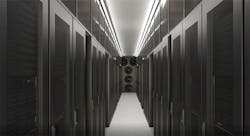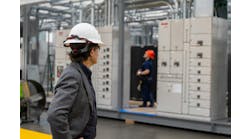Equinix Introduces Factory-Built Data Center Design for Edge Computing
Equinix has introduced a new data center design for edge computing, which uses factory-built modules to add capacity in smaller increments. The new design is being deployed for the first time in a new facility in Bordeaux, France.
The introduction of an edge design is the latest sign of the evolution of Equinix from a colocation provider to a digital infrastructure company that can address needs across the full spectrum of capacity and geography.
The Bordeaux project uses a pre-fabricated design to create a small data center at a cable landing station, a key strategic use case that allows Equinix to provide interconnection services as major subsea cable routes expand to new destinations.
The new design also gives Equinix the ability to compete in the growing market for edge computing, which shifts data and services as close as possible to end users. The trend is driven by the increased use of consumer mobile devices, especially consumption of video and the growth of sensors as part of the Internet of Things (IoT).
The Bordeaux data center will launch with 1 megawatt of power capacity and 220 cabinets of equipment. Additional modules will be added over time to create a 32,280 square foot (3,000 square meter) facility with a final planned capacity of 1,440 cabinets and up to 6 megawatts of power.
That’s a smaller deployment than the traditional Equinix International Business Exchange (IBX) data center. By comparison, the company’s newest facility in Ashburn, Virginia will be about four times the size of the Bordeaux site, and at 124,000 square feet will be able to house about 3,100 cabinets. Equinix is building even larger data centers through its xScale program for hyperscale customers, including a 54-megawatt data center in Tokyo.
New Capabilities for a Changing World
Equinix has built a global data center empire, with 200 data centers and 21 million square feet of space deployed across 52 markets. Equinix has historically focused on the core of the Internet, building clusters of data centers around major network intersections like Northern Virginia, Silicon Valley, Chicago and Dallas.
But the company is now looking to forge an identity that encompasses a broader range of offerings, which now includes hyperscale data centers and software-defined connectivity. The company is also pushing into services with its acquisition of Packet and its bare metal cloud services.
Equinix has been working on the factory-built design for some time, according to Jim Poole, the Vice President for Business Development at Equinix. Poole says it allows Equinix to deliver data centers in faster, smaller chunks for edge use cases.
It also offers versatility in how Equinix consumes power, providing the flexibility to adopt different sources of energy that could include renewables, natural gas, hydrogen fuel cells and large lithium-ion batteries as well as traditional high-voltage power from the local utility.
Pre-Fab Modules for Power, Cooling and IT
In Bordeaux, the pre-fabricated design was ideal for adding data center capacity. near the landing point for the AMITIE subsea cable. Located near the Atlantic coast in the southwest of France, Bordeaux is a pioneer in the smart city movement and home to a concentration of startups and innovation-powered edge industries such as aerospace and optics photonics.
“The use case is that Bordeaux is essentially a cable landing station combined with a retail colocation environment, but one that will take a while to mature,” said Poole. “It’s not in a place where you would normally think to build a data center.”
Enter the new factory-built data center. Poole says the Equinix edge design is “brick-based” and features three modules (bricks) – one for power infrastructure, one for cooling and air handlers, and one for IT equipment.
“Each component fits on a flatbed truck, which makes it easy to transport,” said Poole.
An illustration of the exterior of the completed Equinix edge data center in Bordeaux, France. (Image: Equinix)
When assembled on-site, the standard module supports 250 kW of power, with customization available to support different configurations for capacity and power density. Some implementations will focus on network equipment and be less dense, Poole said, while others deployments may feature more compute capacity and denser racks.
“It can scale up and down as needed,” said Poole, who said the design allows Equinix to expand the site gradually based on demand, a capability that will be important in supporting emerging markets and new applications.
The Bordeaux facility will be staffed similar to traditional IBX data centers, providing support for interconnection and colocation customers who require access to their equipment. Poole said Equinix had the option of running future facilities with little to no staff if that supports the use case. An example might be a small edge data center hosting Equinix Metal bare-metal cloud servers, which can be managed remotely.
Significantly, the pre-fab design can be deployed more rapidly. Poole says a traditional IBX may take 18 to 24 months to complete, while the factory-built design can be completed in less than a year, and likely even faster in the future.
Going Wherever the Data is Headed
Bordeaux is among the new landing sites for subsea communications cables, a sector being disrupted by the growth of cloud computing. These projects reflect the expanding geography of the data center business, as content providers and cloud companies seek new ways to move data around the world. Facebook, Microsoft, Google and Amazon are all investing in undersea cables, in some cases seeking new landing sites to diversify their network infrastructure.
Poole says the Equinix edge design is well suited to support this trend, allowing Equinix to create interconnection services at key network hubs that may not yet be large markets for colocation services – but will be soon.
The potential for cable landings to create colocation demand is a trend we’ve been watching for years at DCF (see The Cloud Brings Colo to Cable Landings from 2016), and the Equinix strategy certainly validates the trend, and makes this niche more competitive.
The edge design also positions Equinix to more easily expand into markets that may lack critical mass by current colocation and interconnection standards, but are strategically important due to data sovereignty or application performance requirements.
“We are looking at what’s going to happen with more data center demand as things like 5G spin up,” said Poole, who says those who don’t consider Equinix an edge company are missing the big picture.
“We think of ourselves as the state-of-the-art at the edge,” said Poole. “Our enterprise customers are always in the process of re-architecting what they do. We think the rest of the world is catching up with us.”






